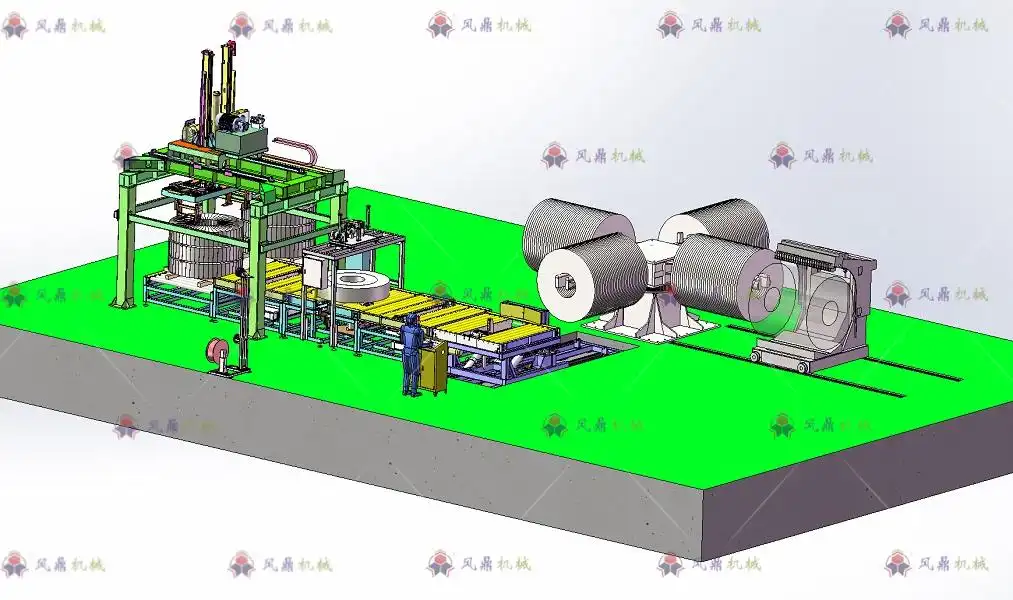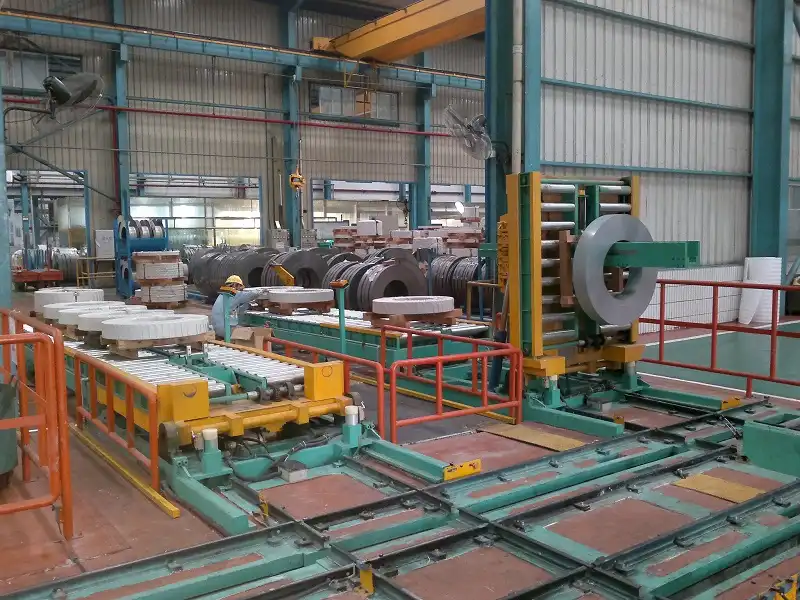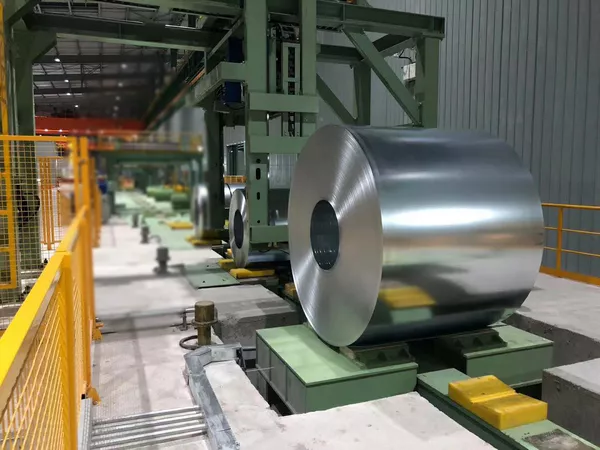Your factory floor is busy. Machines are running, and your team is working hard. But you still feel like you are falling behind. You see stacks of finished steel coils waiting for packing, and you know this delay is a major problem. This bottleneck slows down your entire operation. It risks damaging your products and frustrating your customers. In competitive global markets, like Russia, these small inefficiencies can cost you valuable contracts and hurt your reputation. You know there has to be a better way to handle your end-of-line packing.
Yes, upgrading your coil packing line is one of the most effective ways to gain a competitive edge for the Russian market or any other high-demand region. An automated system directly increases your factory's throughput, improves operational safety, drastically reduces product damage, and lowers your long-term labor costs. This investment empowers you to deliver a higher quality product, faster and more reliably than your competitors.

I understand the pressure you are under. As an engineer who later built his own packing machine factory, I’ve faced these same challenges. You aren't just looking for a new machine. You are looking for a real solution that will make your business stronger. Let's break down the specific problems you are likely facing. We can then see how the right upgrade can turn these challenges into opportunities for growth.
How Can an Automated Packing Line Solve Your Production Bottlenecks?
You have invested heavily in your production machinery. It is fast and efficient. But then, the finished coils reach the end of the line, and everything slows to a crawl. Your packing team is working as fast as they can, but they cannot keep up with the output. This creates a serious bottleneck. Your high-speed production line is forced to wait, which means expensive equipment and skilled operators are sitting idle. This costs you money every minute. This slowdown also delays shipments, which can damage your relationship with customers who depend on you for on-time delivery.
An automated packing line solves production bottlenecks by creating a continuous, predictable, and fast process where there was once a slow and variable one. It replaces the limitations of manual labor with the efficiency of a machine designed to work seamlessly with your production output. This ensures a smooth flow of products from the moment they are made to the moment they are shipped, eliminating costly delays and maximizing your factory's potential.

Deconstructing the Bottleneck
A bottleneck at the packing stage doesn't just affect the packing team. It has a ripple effect across your entire operation. Let's look at how a manual process compares to an automated one. I remember a client, a factory manager in the steel industry, who faced this exact issue. His production line could produce 15 coils per hour, but his manual packing team could only handle 6.
Manual vs. Automated Throughput
The difference in speed is clear when you break down the steps. A manual process is a series of separate, time-consuming actions. An automated system integrates these actions into one fluid motion.
| Packing Stage | Manual Process (Estimated Time per Coil) | Automated Process (Estimated Time per Coil) |
|---|---|---|
| Coil Transport to Station | 3-5 minutes (via overhead crane/forklift) | 1 minute (via integrated conveyor/coil car) |
| Wrapping/Protection | 5-8 minutes (walking around the coil with wrap) | 1-2 minutes (orbital wrapping machine) |
| Strapping | 4-6 minutes (manual tensioning and sealing) | 1 minute (automatic strapping head) |
| Weighing & Labeling | 2-3 minutes (moving to a separate scale) | 0.5 minutes (integrated in-line scale and printer) |
| Total Time | 14-22 minutes | 3.5-4.5 minutes |
As you can see, the manual process is not just slower; it's also inconsistent. The speed depends on the energy and focus of the workers. An automated line delivers consistent output hour after hour. After we helped that factory manager install an automated line, his packing output jumped to over 20 coils per hour, easily keeping pace with his production.
The True Cost of Waiting
The problem goes beyond just the time per coil. A persistent bottleneck creates other issues. Limited floor space becomes filled with unpackaged coils, creating a crowded and unsafe work environment. Production schedules have to be adjusted or paused, leading to lower overall equipment effectiveness (OEE). Shipping logistics become a nightmare because you can't give your transport partners a predictable schedule. By removing the bottleneck with automation, you don't just speed up packing. You create a more organized, efficient, and predictable factory from start to finish.
Is Your Manual Packing Process Putting Your Workers and Profits at Risk?
You see your workers straining to wrap heavy steel coils. You watch them handle strapping tools in awkward positions. You worry about the risk of injury every single day. These manual tasks are not just inefficient; they are dangerous. A single mistake can lead to a serious back injury, a fall, or worse. The cost of a workplace accident is enormous. You face high insurance premiums, lost workdays, the cost of hiring and training replacements, and a drop in team morale. At the same time, manual handling often leads to product damage. A dropped coil or a poorly protected edge results in customer complaints, returns, and lost profits.
Yes, your manual packing process is absolutely putting both your workers and your profits at risk. It directly exposes your employees to the dangers of lifting, pushing, and handling heavy, awkward loads, which is a leading cause of industrial accidents. This same imprecise process also makes your valuable products vulnerable to scratches, dents, and corrosion, turning finished goods into costly scrap or discounted sales. Automation directly addresses both of these risks by design.

The High Price of an Unsafe Environment
Safety is more than just a regulatory requirement; it is a cornerstone of a productive and profitable factory. When I ran my own factory, I learned that the safest way is almost always the most efficient way. Relying on manual labor for heavy tasks is a recipe for problems.
Analyzing the Risks
Let's break down the specific dangers in manual coil packing and how automation provides a clear solution.
| Manual Task | Common Risks | Automated Solution |
|---|---|---|
| Lifting/Moving Coils | Back injuries, crushed feet/hands, muscle strains from using pry bars or manual lifts. | Coil Cars & Conveyors: Automatically and smoothly transport coils to the packing station without manual effort. |
| Turning/Upending Coils | High risk of the coil tipping or falling, causing severe injury or product damage. | Hydraulic Upenders/Tilers: Securely grip and reorient the coil with controlled, predictable motion. |
| Wrapping the Coil | Repetitive strain injuries, slips and falls as workers walk backward around the coil. | Orbital Wrapping Machine: The machine travels around the stationary coil, applying wrap evenly and safely. |
| Strapping the Coil | Hand and wrist injuries from tensioning tools, risk of strap backlash if it snaps. | Automatic Strapping Heads: The machine feeds, tensions, seals, and cuts the strap within a protected enclosure. |
From Product Damage to Profit Protection
Every time a coil is handled manually, it's at risk. The edges are especially vulnerable. A small dent from a forklift tine or a scratch from being pushed on the floor can make the entire coil unacceptable to a quality-conscious customer. I once worked with a client who was writing off nearly 5% of their finished coils due to damage that happened between the production line and the shipping truck. That's a direct hit to the bottom line. An automated system handles every coil with precision. Soft-touch rollers on conveyors, automatic edge protectors, and consistent wrapping tension ensure your product arrives at your customer's door in the same pristine condition it was in when it left your production line. For that client, upgrading their line reduced their damage rate to less than 0.5%, saving them hundreds of thousands of dollars a year.
What's the Real ROI of Upgrading Your Coil Packing System?
You understand the benefits of automation, but the upfront cost of the equipment can seem like a major hurdle. It is easy to look at the price tag and decide to stick with your current manual system. It feels like the safer financial choice. But this thinking is a trap. The truth is, your outdated manual process is costing you money every single day. It is an ongoing expense in the form of high labor costs, wasted packing materials, product damage, and missed sales opportunities due to low output. The cost of inaction is often far greater than the cost of a strategic investment.
The real Return on Investment (ROI) from upgrading your coil packing system is powerful and multifaceted. It is calculated by looking at the drastic reduction in your daily operational costs and the increase in your factory's revenue-generating capacity. You will see immediate savings in labor, material consumption, and product loss. At the same time, you unlock new potential for growth by being able to produce and ship more products, faster. The system quickly pays for itself and then becomes a profit center for your business.

Calculating Your Return
Thinking of an automated line as just an "expense" is the wrong approach. It is a capital investment, just like a new CNC machine or a production press. It is an asset designed to make you more money. To see the full picture, we need to look at all the ways it impacts your finances.
A Sample ROI Breakdown
Let's imagine a factory like yours, running one shift with three workers dedicated to manual packing. We can create a simple, conservative estimate of the potential savings.
| Cost/Savings Area | Manual Process (Annual Cost) | Automated Line (Annual Savings) | Notes |
|---|---|---|---|
| Labor Costs | $90,000 (3 workers x $30k/yr) | $60,000 (Redeployed 2 workers) | The line now needs only 1 operator, not 3 full-time packers. |
| Product Damage | $25,000 (e.g., 2% damage rate) | $20,000 (Damage reduced to 0.4%) | Consistent, gentle handling protects valuable inventory. |
| Packing Material Waste | $5,000 (Inconsistent stretch/use) | $2,000 (Optimized material usage) | Machines use the exact amount of wrap needed, every time. |
| Increased Throughput | - | $50,000+ (New revenue) | Packing 10 extra coils/day can lead to significant new sales. |
| Total Annual Savings/Gain | $120,000 (Total Annual Cost) | $132,000+ | This is the value the new system generates each year. |
If the total investment for a new automated line is, for example, $200,000, you can calculate the payback period:
Investment / Annual Savings = $200,000 / $132,000 = 1.51 years.
In this realistic scenario, the machine pays for itself in just over 18 months. After that, it contributes over $130,000 in pure profit and added capacity to your business every single year.
A Long-Term Strategy for Growth
When I established my own factory, I quickly learned a critical lesson: you must invest in the right equipment to build a sustainable business. Trying to save money by using outdated, labor-intensive methods only works for a short time. Your competitors will get faster, safer, and more efficient. An automated packing line is not about patching a problem. It is about building a foundation for future growth. It allows you to confidently take on larger orders, serve more demanding markets, and operate with a level of professionalism that builds customer trust and loyalty.
Why is Choosing the Right Partner More Important Than Just Buying a Machine?
You have likely had a bad experience with an equipment supplier in the past. They made big promises during the sales process. They showed you impressive brochures and videos. But after you paid and the machine was delivered, they were nowhere to be found. When you had a problem or a question, getting support was nearly impossible. This experience leaves you feeling frustrated and cautious. You have a very expensive piece of equipment that is not performing as promised, and you have lost trust in suppliers.
Choosing the right partner is more important than the machine itself because a true partner delivers a complete, long-term solution, not just a product. A partner uses their deep industry knowledge to help you design the system that perfectly fits your needs. They ensure it integrates smoothly into your existing workflow, and they provide reliable technical support for the entire life of the machine. The success of your investment depends on this expertise and commitment, not just the steel and motors of the machine.

The Difference Between a Vendor and a Partner
In my years in this industry, I have seen the difference between a simple transaction and a real partnership. A vendor sells you what they have on their shelf. A partner helps you build what you actually need. This distinction is critical for a major investment like a packing line.
Vendor vs. Partner: A Clear Comparison
| Aspect | A Typical Vendor | A True Partner (Our Philosophy) |
|---|---|---|
| Focus | Making the sale. Their goal is to close the deal and move on. | Solving your problem. Our goal is your long-term success. |
| Process | Offers you a standard, off-the-shelf machine. | Conducts a deep analysis of your layout, process, and goals. |
| Expertise | Knows their product's specifications. | Understands your industry's challenges (safety, efficiency, materials). |
| Solution | Sells you a standalone machine. | Designs and integrates a total solution that works with your existing line. |
| Support | Limited after-sales service, often hard to reach. | Provides comprehensive installation, training, and lifelong technical support. |
| Relationship | Transactional. The relationship ends after payment. | Collaborative. We see ourselves as an extension of your engineering team. |
My Commitment to You
This philosophy is the reason I founded SHJLPACK. I started my career as an engineer on the factory floor. I know the pressure to meet production targets. I later built and ran my own successful packing machine factory, so I understand the challenges of making smart investments and managing a business. I have been in your shoes.
My goal is not simply to sell machinery. My mission, and the mission of SHJLPACK, is to share the knowledge I have gained to help you succeed. When you have a challenge, I want to help you find the right solution, even if it's just offering advice. When you work with us, you are not just buying a machine. You are gaining a partner who has walked this path before. We are dedicated to understanding your unique problems and building a solution that will fuel your growth for years to come. This is my promise to you.
Conclusion
Upgrading your packing line is a powerful, strategic investment. With the right automated equipment and a genuinely supportive partner, you will improve safety, boost efficiency, and gain a critical advantage.




